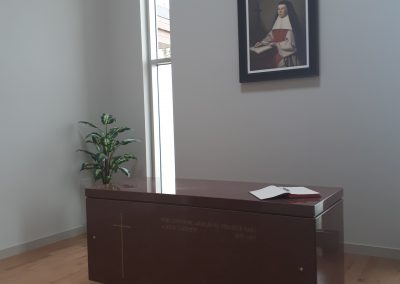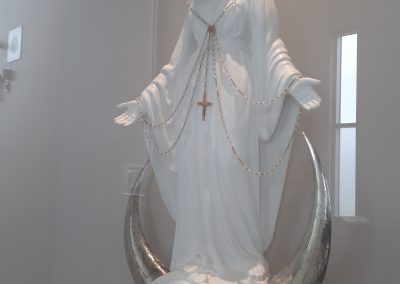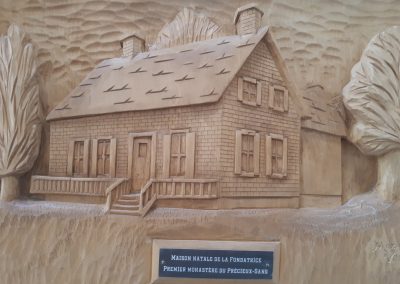Venerable Catherine Aurelia Caouette
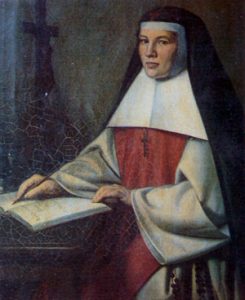 Venerable Catherine Aurelia of the Precious Blood, foundress and superior of the Sisters Adorers of the Precious Blood, was born on July 11, 1833 in Saint-Hyacinthe (formerly in the diocese of Montreal). She was the seventh of nine children.
Venerable Catherine Aurelia of the Precious Blood, foundress and superior of the Sisters Adorers of the Precious Blood, was born on July 11, 1833 in Saint-Hyacinthe (formerly in the diocese of Montreal). She was the seventh of nine children.
From her childhood, she meditated on the Passion, especially by making the Way of the Cross. Her father tells us: When she was four or five years old, I found her in the courtyard one Friday, carrying a piece of wood on her shoulder, the end of which was lying on the ground. Her little face was pale and flooded with sweat; I saw her fall under her heavy burden and get up without seeming to notice my presence; I said to her, “What are you doing, Aurelie, why are you carrying this wood that is too heavy for you?” She jumped up as if I had awakened from a deep sleep and answered, “I am Our Lord carrying his Cross to Calvary.”
Her father recounts that she received the grace to levitate: “Aurelie was seven years old when, one day, her mother sent her to look for an object in an upper room. As the child searched in vain, the mother came to the bottom of the stairs and told her where she could find it, and to hurry and bring it to her. But how surprised the mother was to see Aurelie, holding the object with both hands, put her two feet, one after the other, in the void, that is to say, three or four inches from the steps, and go down like a shooting star. The thing seemed quite natural to Aurelie; her mother asking her if she had not been frightened: “No, mamma, I have already descended the stairs like that.” “Since when,” continued the mother? “Since I went up saying: Hail Mary, at each step” The mother, observing her more attentively, saw her several times going up and down that staircase like that.”
Sister Marie-Angela tells us that the parish priest saw her rise several times from the ground to decorate a statue of the Blessed Virgin placed above the high altar in the church of Our Lady of the Most Holy Rosary.
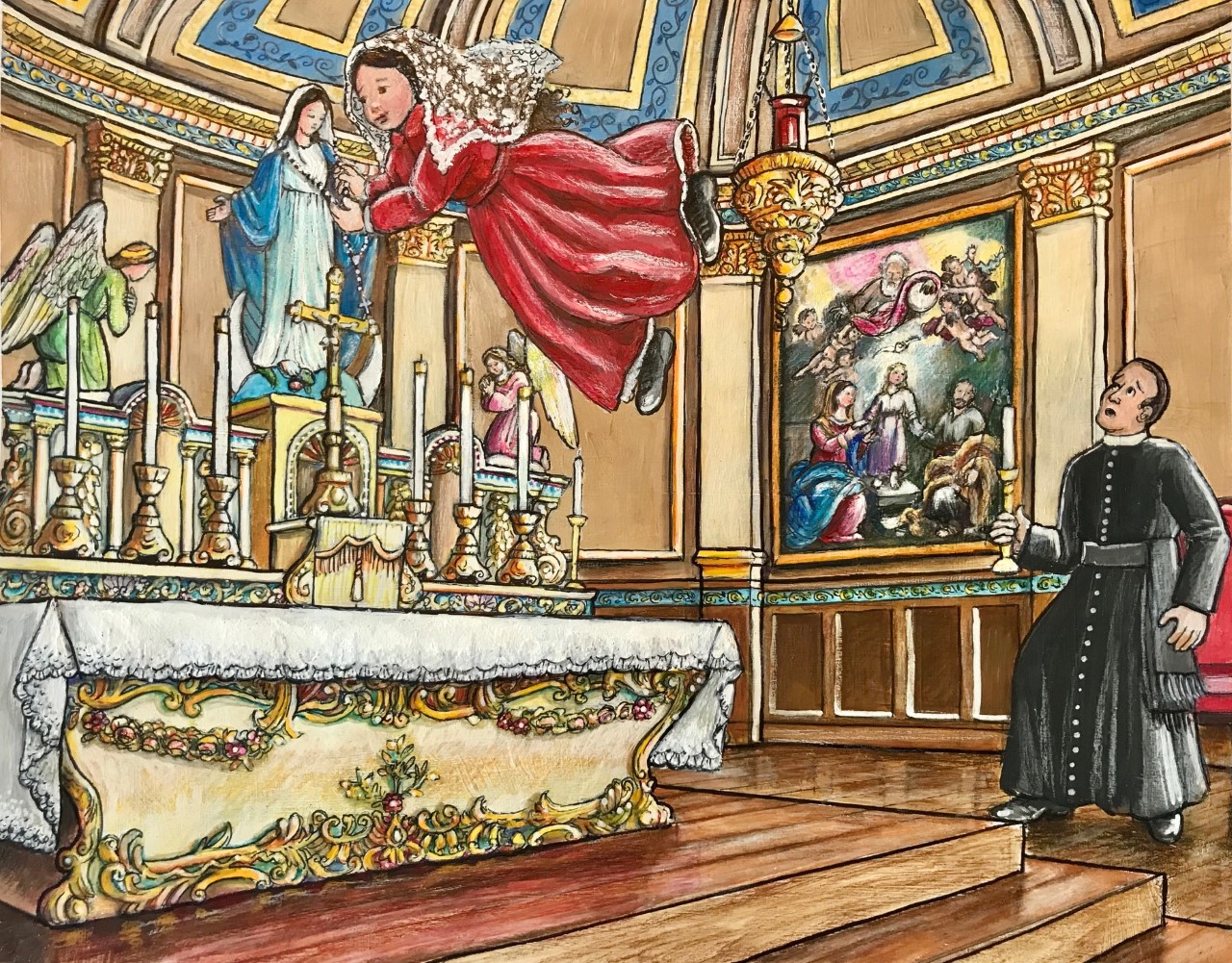
Desire to suffer for Jesus:
From the age of six, she had a devotion to the Eucharist. At six o’clock in the morning, she often walked to church to pray before the tabernacle.
From a young age, she understood the meaning of reparative suffering. She sought all sorts of ways to mortify herself. Concerned to see her mortify herself at her age, her parents went to see Father Édouard Crevier to talk to him about it. He replied: “Heaven has given you a child of predilection, show him your gratitude and watch over your precious treasure”.
From a very young age, Aurelie felt a great desire to suffer for Jesus Christ. External phenomena accompany these states of mind, including strange illnesses, sudden changes in the color of the clothes she wears, objects that become hot in her hands. It also seems that she had repeated visions of Christ bloodied by the crown of thorns. From a very early age, she showed great piety and devoted a special and passionate worship to the precious blood of Christ, which was witnessed only by her parents.
However, people testify that she seemed incredibly happy. One witness said, “Alas! I couldn’t think: ‘My God, how I wish I could be as pious as her! How happy she is to be so devout! So when I saw her going towards the little chapel, I took the path myself; I did not pray, I could not pray, absorbed as I was by her attitude and envious of her happiness.
At the age of 12, she was stricken with smallpox, had to be bedridden and stay in the room for many weeks. It seems that during this illness, she was favored by an apparition of Jesus as a child, that he let himself be seen by her physically and that he smiled at her to encourage her.
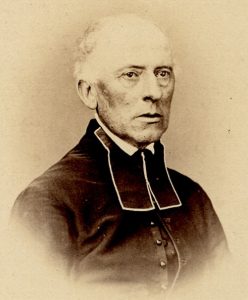 In 1845, when she was 12 years old, Aurelia Caouette entered a boarding school run by the nuns of the Congregation of Notre-Dame in Saint-Hyacinthe. During her studies, she benefited from the spiritual direction of Father Joseph-Sabin Raymond, who was the superior of the seminary in St-Hyacinthe. For the next 40 years, Father Raymond was an attentive witness to the Lord’s action in Aurelia’s privileged soul; for example, he often saw her in ecstasy and assured her of his support at all the more or less painful stages that led her to the foundation of a religious community.
In 1845, when she was 12 years old, Aurelia Caouette entered a boarding school run by the nuns of the Congregation of Notre-Dame in Saint-Hyacinthe. During her studies, she benefited from the spiritual direction of Father Joseph-Sabin Raymond, who was the superior of the seminary in St-Hyacinthe. For the next 40 years, Father Raymond was an attentive witness to the Lord’s action in Aurelia’s privileged soul; for example, he often saw her in ecstasy and assured her of his support at all the more or less painful stages that led her to the foundation of a religious community.
In 1848, Father Raymond asked her to write down her inner feelings as well as the story of the favors and mystical states she was favored with by the Lord. It was this same abbot who helped her found her congregation. She will confess that when she was a student, Jesus often spoke to her through interior locutions. One day, Our Lord said to her: “Come to me through suffering and detachment from every creature”. “It is through suffering that you will be united to me”.
In 1850, when she was 17 years old, Aurelia Caouette left the boarding school and returned to her parents. Fearing that she would fall into the vanities of the world, she decided to draw up a program for her life and to make firm resolutions that she would submit to her spiritual director. Before Father Raymond, she took a vow of chastity and added the name Catherine to her name because of her admiration for the young martyr of Alexandria. She then took a vow of obedience.
Although she was clearly called to religious life, she could not find her way. The first bishop of Saint-Hyacinthe, Bishop Jean-Charles Prince, suggested that she join a teaching community or a hospital community, but Aurelie felt that her vocation was not there.
While living in the world, Aurelia Caouette continued to lead an austere life. She lived an almost cloistered life, divided between prayer, inexplicable physical suffering and occasional assistance to the poor. By dint of asking to suffer for the glory of God and the salvation of souls, she suffered extraordinarily from pains in her chest, ears, thirst, and even in her whole body, to the point that she was often bedridden. She said: “Let us not forget that the rough wood of the Cross is a wonderful wood that serves to light and rekindle the fire of Love”.
Before her, the horizon remains mysterious. However, her devotion to the Precious Blood is becoming more and more profound and imperative. She said: “I feel in me all the energy of the Divine Blood! It is a generous blood that only longs to be shed”.
In August 1854, when events seemed to be at a standstill, Aurelia had a vision of the Blessed Virgin. This happened during a pilgrimage to Notre-Dame de Bonsecours in Montreal, where Aurelia was in search of a serious illness. She describes the vision: “She was dressed in a dazzling white robe and surrounded by a glory so great that I cannot describe it. Then she said to me, ‘Daughter, do not be afraid. If you are as simple as a dove and blindly obey the orders of your spiritual guide, your prayer will be answered, your purity will remain intact, your modesty will be safe from all trials.
News of the apparitions and wonders spread throughout Quebec. Some believed that her visions were the work of God, others disagreed. Often, arguments broke out when the subject was broached: “It is said that her tongue is covered with blood when she receives the host” “And that is not all. Her clothes even change color. Some days they are white as snow. Other times they turn red, like blood.
This is what Father Raymond describes: ”Her eagerness to work and go out in the most difficult weather conditions, despite his constant suffering; his fasting and nightly vigils; instantaneous healings after a prayer or an act of obedience; sudden and unexplained appearances in church; lack of movement and any sensation of pain during ecstasies; a flow of blood from her head, hands, and feet every Friday, and flowing almost daily from her heart; a fragrant odor from her mouth; the warmth of her chest causing objects to heat up; her clothes changing color; and most of all, her immediate response to inner commands. … many of these things happened after a prayer from the bishop or his director. These wonders occur most often after receiving Communion and on days dedicated to the Passion or the Blessed Virgin…”
Our Lord said to her, “Little bride, here is my Blood! It is so full of love for men that my veins can no longer contain it. It flows in torrents and it is let loose… It is necessary that, by your means, it spreads at least on a great number of souls, and that it makes virgins ardent and burning”. She replied, “My whole life, dedicated to the cult of the Blood, will be my song of gratitude.”
One day she received the stigmata. This is what Father Raymond tells us: “She told me that Our Lord had appeared to her crucified, had made her put her hands and feet on his, and that she had seen herself pierced then; and that she had asked God that the pains remain without any wounds. Since then, these pains often returned, especially on Fridays, but were not continuous” (it seems that she received them in 1852). She wrote: “O my God, God of love, take possession of my poor virgin heart. Saturate it with anguish, with tribulations, it deserves it, but spare the sinners”.
She prayed unceasingly: “My God, I implore you, increase in me the desire that I have to love you, to belong to you alone…”.
Many people did not believe in this. Most of the priests of the seminary of St-Hyacinthe did not believe in it. The infatuation with Aurelia’s vocation caused much distress for Father Raymond and for herself.
All the arguments and turmoil caused deep pain to Aurelia’s parents and other members of her family. They understood the value of prayer and penance, but what their daughter was doing sometimes seemed extreme.
One day, overcome with extreme anguish, she saw Our Lord who let her rest on his Divine Heart. Then He said to her: “Blessed are you, my daughter, and do not fear, I am with you”.
In 1859, while Aurelia Caouette was still wondering what God’s will was. Bishop Prince, the bishop of St-Hyacinthe, suggested that she meet with Bishop Ignace Bourget, then bishop of Montreal. He listened attentively to the young mystic. He recounted how he was “struck by the expression of holiness in her person and by the heavenly joy in her eyes, despite the suffering she seemed to be enduring at that very moment. Then, with a prophetic accent, he said to her: “If I were bishop of Saint-Hyacinthe, I would say to you: ‘Go away to a small and solitary cottage and found a community of adorers of the Precious Blood, Daughters of Mary Immaculate. “Aurelia was stunned. The last thing she thought she could hope for had been given to her. In one statement, the bishop had taken the burden off her and pointed to the answer, the only possible answer.
Bishop Bourget wrote to the bishop of St. Hyacinthe to give his opinion. Father Raymond arranged a meeting with the bishop of St. Hyacinthe, who told him: “You will be surprised to learn that the word of a certain remarkable girl from St. Hyacinthe has reached Montreal… Father Raymond is convinced that God is calling you to a life of sacrifice and perfection. After the meeting, the bishop gave his approval. However, his death on May 5, 1860, delayed the realization of the project.
The new bishop of Saint-Hyacinthe, Bishop Joseph La Rocque, hesitated to give his approval to the foundation of this community. However, Father Raymond, the spiritual director of Aurelia Caouette, succeeded in convincing him. Finally, the congregation of the Sisters Adorers of the Precious Blood was founded on September 14, 1861. Almost at the same time, Aurélie’s mother died. Her father donated his house to welcome the first contemplative community in Canada. Aurelie soon had two other companions of the Precious Blood alongside Sophie Raymond, Father Raymond’s niece. Elizabeth Hamilton, whom Aurelia had known as a young music teacher at the convent in St. Hyacinthe and Aurelia’s first cousin Euphrasie Caouette.
The four members of the first contemplative community in Canada first lived in the house of Aurelia’s father. On September 14, 1863, the nuns moved into their own monastery. That same day, Aurelia Caouette took her vows and became Mother Catherine Aurelia of the Precious Blood and Superior. She composed a document called Sitio (I am thirsty), which would become the basis of their rule. She founded the Sisters Adorers of the Precious Blood, an institute of nuns who should strive to adore the Divine Savior and to make reparation, through their love and daily immolations, for the contempt and sins of men.
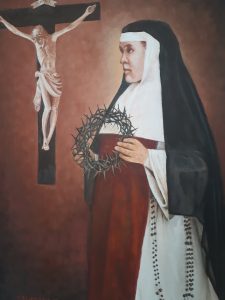 Our Lord said to her: “Little bride, here is my Blood! It is so full of love for men that my veins cannot contain it. It flows in torrents and it is let loose… It is necessary that, by your means, it spreads at least on a great number of souls, and that it makes virgins ardent and burning”. She answered: “My whole life, dedicated to the cult of the Blood, will be my song of gratitude.”
Our Lord said to her: “Little bride, here is my Blood! It is so full of love for men that my veins cannot contain it. It flows in torrents and it is let loose… It is necessary that, by your means, it spreads at least on a great number of souls, and that it makes virgins ardent and burning”. She answered: “My whole life, dedicated to the cult of the Blood, will be my song of gratitude.”
Aurelia Caouette died on July 6, 1905 at the community’s monastery in Saint-Hyacinthe. Her death did not go unnoticed because the numerous mystical phenomena she was the object of brought her to the attention of her contemporaries. Her tomb, which was located for a long time in the motherhouse of the Sisters Adorers of the Precious Blood, was moved in 2015 to a mausoleum in the cemetery of the Cathedral of Saint-Hyacinthe. It is located at 1075 Girouard Street East, Saint-Hyacinthe, Qc.
Sources:
Abbé Élie-J. Auclair, Histoire de Mère Catherine-Aurélie du Précieux-Sang, née Aurélie Caouette, Fondatrice de l’institut du Précieux-Sang
Dom Gérard Mercier, o.s.b, Aurélie Caouette, femme au charisme bouleversant, volume V, Éditions Paulines

